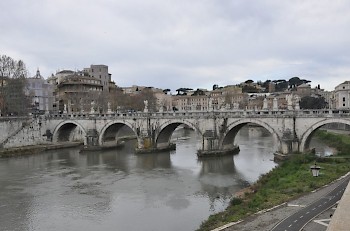Rome, Bridge of Aelius
Q870476Bridge of Aelius: the bridge that connected the Mausoleum of Hadrian to the city of Rome.

Hadrian (r.117-138) was one of the most "visible" of all Roman emperors. In many aspects, he tried to follow the example of the founder of the empire, Augustus. One of the emulations was the building of a large mausoleum near the Tiber.
He was not unoriginal, however. There were striking differences between the two monuments. The most important of these was that the Mausoleum of Augustus was accessible from all sides, whereas the Mausoleum of Hadrian could only be reached by crossing the river Tiber.
The bridge was called Pons Aelius, which can be translated as "Hadrian's bridge", because the full name of the emperor was Publius Aelius Hadrianus. Because one could approach the mausoleum only by walking across the bridge, the funeral monument looked splendidly symmetrical. For centuries, it served as the Pope's fortress and today, it is called the Castel Sant' Angelo. (The baroque statues of the angels were added in 1668 and were designed by Gianlorenzo Bernini.)
Perhaps there was no need to build the Pons Aelius, because a mere 300 meters downstream, one could cross the Bridge of Nero. On the other hand, the district on the other bank of the Tiber appears to have become a popular place for burial (the apostle Peter was one of those who found his last resting place in this area) and it is possible that the capacity of the Pons Neronianus had become insufficient.
Hadrian's Bridge and the Bridge of Fabricius are the only bridges of ancient Rome that have remained more or less intact for the past centuries. An inscription that was still visible in the eighth century (recorded by the "Anonymous of Einsiedeln") allows us to date the inauguration of the bridge to 134. It is unlikely that the emperor was present: he was probably in Judaea, fighting against Bar Kochba, a Jewish messianic claimant.
During the Middle Ages, Hadrian's Bridge was the most important connection between the city of Rome and the Vatican. Over the centuries, the road bed and access ramps have been restored several times but still, the four piers and the three central arches are original.